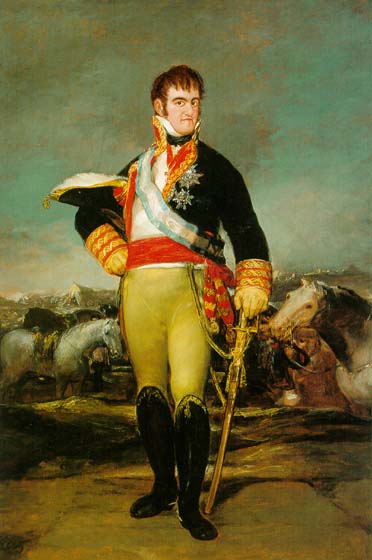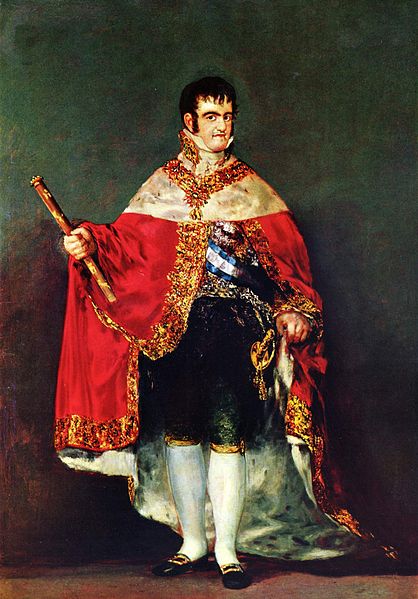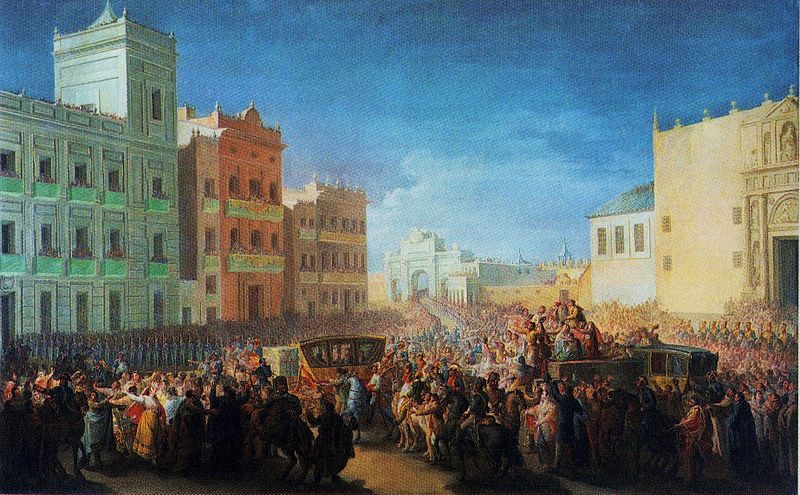<Back to Index>
- Sociologist Helmut Schelsky, 1912
- Poet Edward Estlin Cummings, 1894
- King of Spain Ferdinand VII, 1784
PAGE SPONSOR


Ferdinand VII (14 October 1784 – 29 September 1833) was twice King of Spain: in 1808 and from 1813 to 1833 — the latter period in dispute with Joseph Bonaparte. He was known as "Ferdinand the Desired".
The eldest surviving son of Charles IV, King of Spain, and of his wife Maria Luisa of Parma, Ferdinand was born in the vast palace of El Escorial near Madrid. His name in full was Fernando María Francisco de Paula Domingo Vicente Ferrer Antonio José Joaquin Pascual Diego Juan Nepomuceno Januario Francisco Francisco Javier Rafael Miguel Gabriel Calixto Cayetano Fausto Luís Ramón Gregorio Lorenzo Geronimo.
In
his youth he occupied the painful position of an heir apparent who was
jealously excluded from all share in government by his parents and the
royal favorite Manuel de Godoy.
National discontent with a feeble government produced a revolution in
1805. In October 1807, Ferdinand was arrested for his complicity in the Conspiracy of the Escorial in
which liberal reformers aimed at securing the help of the emperor
Napoleon. When the conspiracy was discovered, Ferdinand betrayed his
associates and grovelled to his parents. When his father's abdication was extorted by a popular riot at Aranjuez in March 1808, he ascended the throne but
turned again to Napoleon, in the hope that the emperor would support
him. He was in his turn forced to make an abdication on 6 May 1808 but his father had relinquished his rights to the Spanish throne on 5 May 1808 (the previous day) in favour of Emperor Napoleon, so Ferdinand effectively had given the throne to Napoleon. Napoleon kept Ferdinand under guard in France for six years at the Chateau of Valençay. While the upper echelons of the Spanish government accepted his abdication and Napoleon's choice of new monarch, his brother Joseph Bonaparte, the Spanish people did not. Uprisings broke out throughout the country, marking the beginning of the Peninsular War. Provincial juntas were established, since the central government had acknowledged Joseph. After the Battle of Bailén proved that the Spanish could resist the French, the Council of Castile reversed itself and declared null and void the abdications of Bayonne on 11 August 1808. Several days later, on 24 August, Ferdinand VII was proclaimed king of Spain again, and
negotiations between the Council and the provincial juntas for the
establishment of a Supreme Central Junta were completed. Subsequently,
on 14 January, the British government acknowledged Ferdinand VII as king of
Spain. Five
years later after experiencing serious reverses on many fronts, Emperor
Napoleon agreed to acknowledge Ferdinand VII as king of Spain on 11
December 1813 and signed the Treaty of Valençay,
so that the king could return to Spain. This, however, did not happen
until Napoleon was nearly defeated by the allied powers several months
later. The Spanish people, blaming the liberal, enlightened policies of
the Francophiles (afrancesados) for causing the Napoleonic occupation and the Peninsular War by allying Spain too closely to France, at first welcomed Fernando.
Ferdinand soon found that in the intervening years a new world had been
born of foreign invasion and domestic revolution. In his name Spain
fought for its independence and in his name as well juntas had
governed Spanish America. Spain was no longer the absolute monarchy he
had relinquished six years earlier. Instead he was now asked to rule
under the liberal Constitution of 1812.
Before being allowed to enter Spanish soil, Ferdinand had to guarantee
the liberals that he would govern on the basis of the Constitution,
but, only gave lukewarm indications he would do so. On 24 March the French handed him over to the Spanish Army in Girona, and thus began his celebratory procession towards Madrid. During this process and in the following months, he was encouraged by
conservatives and the Church hierarchy to reject the Constitution. On 4
May he ordered its abolition and on 10 May had the liberal leaders
responsible for the Constitution arrested. Ferdinand justified his
actions by claiming that the Constitution had been made by a Cortes illegally
assembled in his absence, without his consent and without the
traditional form. (It had met as a unicameral body, instead of in three
chambers representing the three estates: the clergy, the nobility and the cities.) Ferdinand initially promised
to convene a traditional Cortes, but never did so, thereby reasserting the Bourbon doctrine that sovereign authority resided in his person only. Meanwhile, the wars of independence had broken out in America, and although many of the republican rebels were divided and royalist sentiment was strong in many areas, the Manila galleons and tax revenues from the Spanish Empire had been interrupted. Spain was all but bankrupt. Ferdinand's restored autocracy was guided by a small camarilla of his favorites,
although his government seemed unstable. Whimsical and ferocious by
turns, he changed his ministers every few months. "The King", wrote Friedrich von Gentz to the Hospodar John Caradja on
1 December 1814, "himself enters the houses of his first ministers,
arrests them, and hands them over to their cruel enemies"; and again,
on 14 January 1815, "The king has so debased himself that he has become
no more than the leading police agent and gaoler of his country." The king did recognize the efforts of the foreign powers on his behalf. As the head of the Spanish Order of the Golden Fleece Ferdinand made the Duke of Wellington, head of the British forces on the Peninsula, the first Protestant member of the order. In 1820 his misrule provoked a revolt in favor of the Constitution of 1812 which began with a mutiny of the troops under Col. Rafael del Riego and the king was quickly made prisoner. He grovelled to the insurgents as he had done to his parents. Ferdinand had restored the Jesuits upon
his return; now the Society had become identified with repression and
absolutism among the liberals, who attacked them: twenty-five Jesuits
were slain in Madrid in 1822. For the rest of the 19th century,
expulsions and re-establishment of the Jesuits would continue to be
touchmarks of liberal or authoritarian political regimes. At the beginning of 1823, as a result of the Congress of Verona, the French invaded Spain "invoking the God of St Louis, for the sake of preserving the throne of Spain to a descendant of Henry IV, and of reconciling that fine kingdom with Europe." When in May the revolutionary party carried Ferdinand to Cádiz, he continued to make promises of amendment until he was free. When freed after the Battle of Trocadero and
the fall of Cádiz he revenged himself with a ferocity which
disgusted his far from liberal allies. In violation of his oath to
grant an amnesty he avenged himself, for three years of coercion, by
killing on a scale which left his "rescuers" sickened and horrified.
The Duke of Angoulême, powerless to intervene, made known his
protest against Ferdinand's actions by refusing the Spanish decorations
Ferdinand offered him for his military services. During
his last years Ferdinand's energy was abated. He no longer changed
ministers every few months as a sport, and he allowed some of them to
conduct the current business of government. He became torpid, bloated
and unpleasant to look at. His last ten years of reign (1823 – 1833) are
generally known as the "Ominous Decade"
, and saw the relentless restoration of a reactionary absolutism, the
re-establishment of archaic university programs and the suppression of
any opposition, both of the Liberal Party and of the reactionary revolt
(known as "War of the Agraviados") which broke out in 1827 in Catalonia and other regions. After his fourth marriage, with Maria Christina of Bourbon - Two Sicilies in 1829, he was persuaded by his wife to set aside the law of succession of Philip V,
which gave a preference to all the males of the family in Spain over
the females. His marriage had brought him only two daughters. The
change in the order of succession established by his dynasty in Spain
angered a large part of the nation and led to a civil war, the Carlist Wars. When
well he consented to the change under the influence of his wife. When
ill he was terrified by priestly advisers who were partisans of his
brother Carlos. Ferdinand died on 29 September 1833 in Madrid. King Ferdinand VII kept a diary during the troubled years 1820 - 1823 which has been published by the Count de Casa Valencia. Ferdinand VII was married four times. In 1802 he married his first cousin Princess Maria Antonietta of the Two Sicilies (1784 – 1806), daughter of Ferdinand I of the Two Sicilies and Marie Caroline of Austria. There were no children, because her two pregnancies (in 1804 and 1805) ended in miscarriages. In 1816, he married his niece Maria Isabel de Bragança, Princess of Portugal (1797 – 1818), daughter of his older sister Carlota Joaquina and John VI of Portugal. Their only daughter lived only four months. In 1819, he married Princess Maria Josepha of Saxony (1803 – 1829), daughter of Maximilian, Prince of Saxony, and Caroline of Bourbon - Parma. No children were born from this marriage. Lastly, in 1829, he married another niece, Maria Christina of Bourbon - Two Sicilies (1806 – 1878), daughter of his younger sister Maria Isabella of Spain and Francis I of the Two Sicilies. She bore him two daughters: Isabella II and Luisa Fernanda (1832 – 1897), who married Antoine d'Orleans, Duke of Montpensier.
